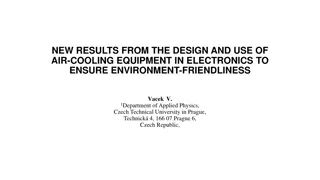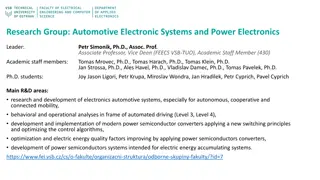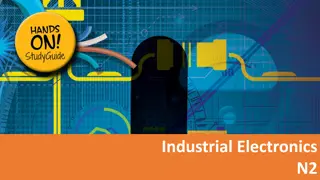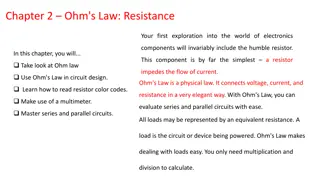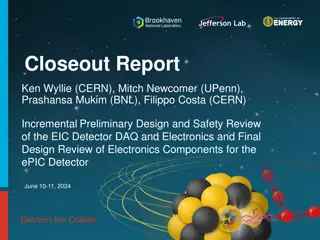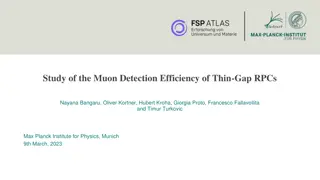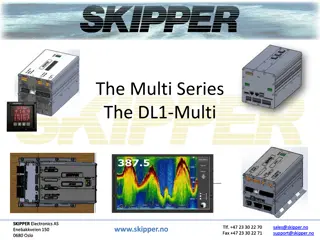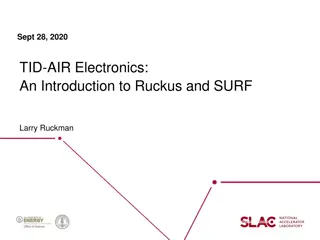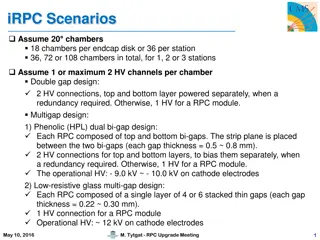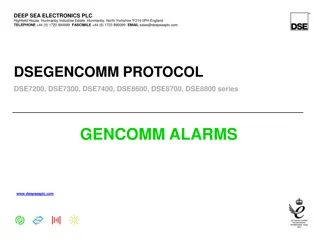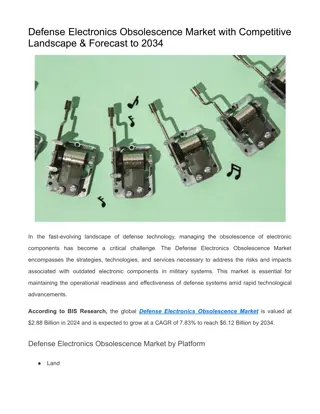Electronics Techniques for Research in PowerPoint Presentation
Dive into the Spring 2020 semester of Physics 53600 with Prof. Matthew Jones, exploring serial digital data transfer, RS-232, RS-485, and more. Changes to grading schemes and assignments are outlined, along with announcements for the course.
Download Presentation

Please find below an Image/Link to download the presentation.
The content on the website is provided AS IS for your information and personal use only. It may not be sold, licensed, or shared on other websites without obtaining consent from the author.If you encounter any issues during the download, it is possible that the publisher has removed the file from their server.
You are allowed to download the files provided on this website for personal or commercial use, subject to the condition that they are used lawfully. All files are the property of their respective owners.
The content on the website is provided AS IS for your information and personal use only. It may not be sold, licensed, or shared on other websites without obtaining consent from the author.
E N D
Presentation Transcript
Physics 53600 Electronics Techniques for Research Now in PowerPoint! Spring 2020 Semester Prof. Matthew Jones
The usual ANNOUNCEMENT Obvious changes to the course: No in-person lectures: you ll have to read the lecture notes yourself No more labs: don t worry about it your grade will be based on work done so far Remaining assignments will try to cover topics that would have been explored in the lab Second mid-term: simplest to cancel it Final exam: I m not sure what to do about this yet, but I ll figure something out. Changes to grading scheme: Old scheme: Assignments (30%) exams (40%) lab (30%) New scheme: Assignments (50%) exams (25%) lab (25%)
The usual ANNOUNCEMENT Because there won t be any in-person lectures, you will have to read the lecture notes yourself. To demonstrate that you have read them, you will be required to answer one or two simple questions before the next lecture is posted. The question will be somewhere (like maybe at the end?) and you just have to e-mail me the answer mjones@physics.purdue.edu To make this easy, please make your subject look like this: PHYS53600 Lecture xx questions Your Name These will be part of your assignment grade, maybe contributing 10% of your total grade.
More ANNOUNCEMENTS Feel free to send me questions about the lecture material if there is anything you don t understand. I m happy to give more explanation (and I m soooo bored.) Send me e-mail if you think it would be useful to arrange a time as a class to have a time where you can ask questions by video.
LECTURE 22 QUESTIONS 1. Why did the original RS-232 standard use such large voltage swings on its signals? 2. What are some advantages of RS-485 compared with RS-232? 3. What are the main differences between RS- 422 and RS-485?
Serial Digital Data Transfer So far we have considered various types of data transfer (both serial and parallel) All types we have considered use a clock signal (or strobe, or whatever you want to call it) to synchronize the sampling of a data signal This works, provided the data satisfies well- defined setup and hold times. Today we will investigate two other forms of serial communication that don t explicitly transmit clock signals
Serial Data Transfer We can first motivate the problem by considering transmitting serial data over a long distance (a few meters to a few hundred meters) Then, if we can make this work then it should (in principle) work even better (ie, faster) over shorter distances
Serial Interfaces With the emergence of mainframe computers in the 1950 s-1980 s, the human interfaces were usually located far away from the main computing hardware 100 meters Located in a carefully controlled secure area Located in a publically accessible area
Signal Skew Obviously it will be easier and less expensive to have fewer signals (ie, wires) in an interface But, if we send a dedicated clock signal then we must guarantee that the setup and hold times are respected even when the cable is very long Without careful physical construction (which adds expense) it can be hard to guarantee that the electrical length of all conductors in a cable are the same. It might work, but maybe can only be guaranteed to work at low speeds.
Serial Data Transmission Let s consider a scheme where we ONLY transmit the data signal This would only require two conductors The problem is that the receiver doesn t necessarily know when to sample the data This is the basic problem with all serial communication and it is solved in various ways Both receiver and transmitter must agree on the format of the data and the receiver can use this to deduce a local sample clock signal
Universal Asynchronous Receiver/Transmitter This is the scheme used for several serial protocols (RS-232, RS-485, ) Both receiver and transmitter have their own internal clocks These clocks need to run at approximately the same frequency There is no way to guarantee the phase difference These internal clocks determine the rate at which bits are sent and received This is called the baud rate
Baud Rate Both receiver and transmitter start with a local oscillator that runs at about 1.8432 MHz This is divided by integer factors to produce specific baud rates: Baud rate Divisor 300 6144 1200 1536 2400 768 9600 192 19,200 96 38,400 48 115,200 16
Start Bits The transmitter begins by sending a START bit The receiver detects the start bit and knows (approximately) what the phase of bit boundaries are
Data Bits After the start bit is detected, the transmitter can send a number of data bits Both transmitter and receiver need to agree on how many After the data has been transferred, the transmitter must get ready to send another start bit This is like a STOP bit, and returns the signal to the opposite logic state of the START bit so that the next START edge can be detected
Error Detection There are several ways to improve the signal-to- noise ratio on the electrical signals Remember Shannon s channel capacity theorem? If errors are still possible, then there are some simple ways to detect them At least you can try to detect some of them One simple scheme is to transmit a parity bit that ensures that the total number of 1-bits in the data+parity is either even or odd: Even parity: Only an even number of 1 bits Odd parity: Only an odd number of 1 bits
Error Detection The bit-error-rate (BER) is the rate at which bits are incorrectly received. Parity will detect the flips of any single bit in the data+parity word Example with 8-bit data words and one parity bit: P(no errors) 1-BER9 P(one error) 9 x BER P(two errors) 9 x 8 x BER2 There is still a (small) chance that there will be two bit flips in one word This will not be detected by the parity bit
Physical Interface The protocol for transferring serial data is specified at the bit level (logic 0 or 1) Physically, the electrical connections can be implemented in various ways. It can also be convenient to provide other signals to help with data synchronization Physical connectors: DB-9 (male and female) DB-25 (male and female) RJ-11 RJ-45 often vendor dependent No really good universal standard
DB-9 Connectors This is usually the bare minimum number of signals that are used CTS and RTS signals are used for flow-control.
RJ-45 Connectors RJ-45 connectors are convenient because they can use regular CAT-4/5 Ethernet cables with inexpensive connectors at both ends Sometimes you have to make adapters to connect up your own weird equipment
Electrical Interface The original RS-232 specification used large voltage swings to increase the signal-to-noise ratio The voltage levels were called mark and space :
Electrical Interface In practice, it can be quite inconvenient to work with 15 volt signals in digital circuits. There are driver IC s that will translate standard 3.3V or 5V logic levels to these higher voltages For example:
Disadvantages of RS-232 The signals are single-ended Noise is added linearly to the voltage being driven The voltage swings are potentially large They can radiate noise that might interfere with other circuits The signals are ground-referenced Both pieces of equipment have to be connected to the same electrical ground or else large currents might flow in the cable The signals are point-to-point You can t share the signals with multiple devices on the same cable
RS-422/RS-485 Electrical Specification The RS-422/RS-485 specification attempts to address many of these deficiencies. The data that is transferred is still sent/received using the UART protocol Additional conventions are required to allow multiple devices to share the same bus
RS-422/RS-485 Electrical Specification Both use a single pair of wires to transfer differential signals: There is no common ground connection The wires act as a transmission line, so ZT is needed to prevent reflections at the receiving end.
RS-422 Specification With the RS-422 specification, one transmitter (the master) can send data to many (up to 10) receivers (slaves) The master can also receive data (on a separate pair of signals) from many slaves that share the bus The slaves have to decide who will transmit data at any given time. Cables can be long! Up to 1 km with data rates less than 100 kbps (kilo-bits per second)
RS-485 Specification The RS-485 specification is built on the RS-422 specification They use the same differential signals But the pair of signals is truly bidirectional Not only can there be multiple slaves, but there can also be multiple masters Up to 32 drivers and 32 receivers on a single pair Now all the devices need to coordinate who will be driving the pair at any given time.
Example RS-485 Communications A standard communication protocol is needed to make this work One example is the MODBUS protocol Each device is assigned an 8-bit address Data is organized as a set of 16-bit registers The master sends data in the following format:
Example RS-485 Communications The master then releases the bus (goes to a high impedance state and starts listening) The slave then transmits a response: Error checking is performed by constructing a 16- bit word from the data If the word calculated from the received data does not match the transmitted data, then an error must have occurred.
Examples of RS-485 Equipment Lots of industrial equipment uses RS-485 for communications. Most computers do not have a specific RS-485 interface. You can buy RS-485 to USB converters:


